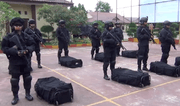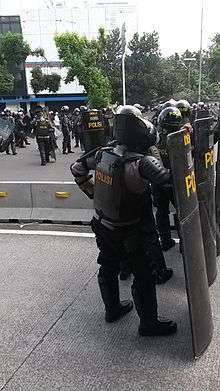Mobile Brigade Corps (Brimob)
| Indonesian Mobile Brigade Corps (BRIMOB) | |
|---|---|
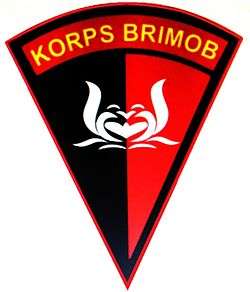 | |
| Active | 14 November 1946 - now |
| Country |
|
| Branch |
|
| Type |
|
| Role |
|
| Size | 34.250 personnel[2] (2008) |
| Garrison/HQ | Mako Brimob Kelapa Dua, Cimanggis, Depok |
| Motto(s) |
|
| Colors | Dark Blue berets |
| March | Mars Brimob |
| Mascot(s) | Lotus Flower (Bunga Teratai) |
| Engagements |
World War II Indonesian National Revolution East Timor Conflict Indonesia–Malaysia confrontation West Papua confrontation Aceh Conflict Poso Conflict May 1998 riots of Indonesia 2016 Jakarta attacks |
| Commanders | |
| Current commander | Police Inspector General Murad Ismail |
| Notable commanders | Police General Anton Soedjarwo |
| Insignia | |
| Identification symbol |
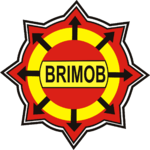 |
The Mobile Brigade Corps (Indonesian: Korps Brigade Mobil) abbreviated BRIMOB is the special police operations force and paramilitary law enforcement of Indonesia. It is also known as for being the oldest units in the Indonesian National Police. Its duties are counter-terrorism, high-threat law enforcement, riot control, police raid, search and rescue, anti-anarchist, and Bomb disposal in urban settings. The Mobile Brigade Corps is a large component of the Indonesian National Police trained for counter-separatist and counter-insurgency duties, often in conjunction with military operations.[2]
The Mobile Brigade is also known as the special "anti-riot" branch of the Indonesian National Police which deals with special operations. A paramilitary organization, its training and equipment is almost identical to the Indonesian Army's ("TNI"), and it conventionally operates under joint military command in areas such as Papua and, until 2005, Aceh.[3]
The Mobile Brigade, which began forming in late 1946 and was used during the anti-Dutch Revolution, started sending students for US Army SF training on Okinawa in January 1959. In April 1960 a second contingent arrived for two months of Ranger training. By the mid-1960s the three-battalion Mobile Brigade, commonly known as Brimob, had been converted into an elite shock force. A Brimob airborne training centre was established in Bandung. Following the 1965 coup attempt, one Brimob battalion was used during anti-Communist operations in West Kalimantan. In December 1975 a Brimob battalion was used during the East Timor operation. During the late 1970s, Brimob assumed VIP security and urban anti-terrorist duties. In 1989, Brimob still contained airborne-qualified elements. Pelopor ('Ranger') and airborne training takes place in Bandung and at a training camp outside Jakarta.[4] Historically, Brimob wore the Indonesian spot camouflage pattern during the early 1960s as their uniform.[4]
History
Formed in late 1945 as a special police corps named Pasukan Polisi Istimewa (Special Police Troops) with the task of disarming remnants of the Japanese Imperial Army and protecting the chief of state and the capital city. Under the Japanese, it was called Tokubetsu Keisatsutai (特別警察隊). It fought in the revolution and was the first military unit to engage in the Battle of Surabaya under the command of Police Inspector Moehammad Jasin.
On 14 November 1946, Prime Minister Sutan Sjahrir reorganised the Polisi Istimewa into the Mobile Brigade (Mobrig). This day is celebrated as the anniversary of this Blue Beret Corps. This Corps was reconstituted to suppress military and police conflicts and even coups d'etat.
On 1 December 1947 Mobrig was militarized and later deployed in various conflicts and confrontations like the PKI Rebellion in Madiun, DI Rebellion (1947), APRA Rebellion and RMS Proclamation (1950), PRRI People Rebellion (1953), and Permesta (1958).
As of 14 November 1961, the Mobrig changed its name to Korps Brigade Mobil (Brimob), and its troops took part in the military confrontation with Malaysia in the early 1960s and in the conflict in East Timor in the mid-1970s. After that, Brimob was placed under the command of the Indonesian National Police.
In 1981, the Mobile Brigade spawned a new unit called the Jihandak (Penjinak Bahan Peledak), an explosive ordnance disposal (EOD) unit.
Task
The Implementation and mobilization of the Brimob Corps is to cope with high-level interruption of society mainly: mass riots, organized crime armed with fire, search and rescue, explosives, chemicals, biological and radioactive threats along with other police operational implementing elements in order to realize legal order and peace of society throughout juridical of Indonesia and other tasks assigned to the corps.
Qualifications
The Pelopor qualifications which are the basic capabilities of every Brimob member are required to have the following basic skills:
- Ability in navigation of Map and Compass
- Intelligence
- Anti Terror (counter-terrorism)
- Riot Control
- Guerrilla War, Close / City War Tactics
- Bomb Disposal
- Handle High Intensity Crime where the use of weapons is present
- Search and Rescue
- Surveillance, Disguise and Prosecution.
- Individual and Unit Capabilities.[5]
Function

The function of the Police's Mobile Brigade Corps as the Polri's Ultimate Unit which has specific capabilities (Riot control, Combat Countermeasures, Mobile Detective, Counter-terrorism, Bomb Disposal, and Search and Rescue) in the framework of High-level domestic security and community-supported rescue personnel who are well trained and have solid leadership, equipment and supplies with modern technology.
Role
The role of Brimob is together with other Police functions is to act against high-level criminals, mainly mass riots, organized crime of firearms, bombs, chemicals, biology and radio active threats in order to realize the legal order and peace of society in all juridical areas of Indonesia. Roles undertaken include:
- Role to help other police functions.
- Role to complete in Police Operations undertaken in conjunction with other Police functions.
- Role to Protect members of the Police and the civilians who are under threat.
- Contribute to Strengthen other Police functions in the implementation of Operational duties.
- Serve to replace and handle territorial Police duties if the situation or task objective has already led to a High-grade crime.[6]
Organisation

In 1992 the Mobile Brigade was essentially a paramilitary organisation trained and organised along military line. It had a strength of about 12,000. The brigade was used primarily as an elite unit for emergencies and supporting police operations as a rapid response unit. The unit was deployed in domestic security and defense operations, and to perform these tasks the unit is equipped with special riot-control equipment. They are trained to deal with mass demonstrations.
Since the May 1998 upheaval, PHH (Pasukan Anti Huru-Hara, Anti Riot Unit) have received special anti-riot training. Elements of the unit are cross trained for airborne and Search and Rescue operations. In each Police HQ that represents a province (which is known as POLDA) in Indonesia must have a BRIMOB force which consists of several Detachments of Pelopor and usually 1 - 2 detachment of GEGANA.
The Indonesian Police Chief, known as KAPOLRI, has the highest command in each police operation including BRIMOB, orders are delivered by the police chief and then executed by his Operational Assistant Agent with then further notification to the BRIMOB commander.
Units
- Brimob Corps Education Center
- I (1st) Gegana Unit
- II (2nd) Pelopor Regiment
- III (3rd) Pelopor Regiment
Pelopor
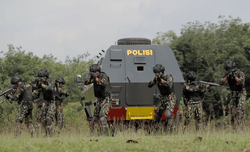
Pelopor is the main reaction force of the Mobile Brigade Corps, it acts as a troops formation and has the roles such as mainly riot control and conducts Paramilitary operations assigned to the corps to cope with high-level threat of society disturbance. It also specializes in the field of Guerrilla, and Search and Rescue (SAR) operations. There are two Regiments of Pelopor in the Brimob corps which are:
- II Pelopor Regiment
- III Pelopor Regiment
In a historical view, this unit was called as "Brimob Rangers" during the Post Independence era. In 1959, during its first formation, Brimob Rangers troops conducted a test mission in the area of Cibeber, Ciawi and Cikatomas which borders Tasikmalaya-Garut in West Java. In this assignment they often faced the inhibition by the gang of DI / TII in large quantities, guerrilla anti-guided techniques tested in this test mission.
The official assignment of Brimob Rangers is the Fourth Military Operations Movement in South Sumatra, West Sumatra and North Sumatra. In this GOM IV Brimob Rangers troops became part of Infantry Bangka Belitung Battalion led by Lieutenant Colonel (Inf) Dani Effendi. Rangers troops have a special task to capture the remains of the PRRI prison that is still in guerrilla in Sumatra's forest led by Major Malik.
In 1961 precisely at the time of the Chief of Police Soekarno Djoyonegoro, Brimob Rangers troops experienced a change of name to the Pelopor. This is in accordance with the wishes of President Soekarno who wants Indonesian names for units within TNI (Indonesian Armed Forces) and POLRI (Indonesian National Police). At this time also the Pelopors received weapons that became their trade mark of AR-15. The subsequent assignment of this force was to infiltrate West Irian in Fak-Fak in May 1962 and engage in combat with the Dutch Army. The troops were also involved in the Confrontation of Malaysia in 1964 and at that time the Brimob Rangers troops (now Pelopor) in Indonesia faced the SAS elite unit of England.[7]
Now the Pelopor plays a role as a troop formation unit and is still active in Brimob's operational system.
Gegana

Gegana is a special wing within Brimob which have special abilities mainly in bomb disposal and counter-terrorist operations. On the other hand, it also specializes in the field of hostage rescue, intelligence and the handling of Chemical, Biological, and Radio Active threats. It has 5 (five) detachments which are:
- Intelligence Detachment
- Bomb Disposal Detachment
- Anti-Terror Detachment
- Anti-Anarchist Detachment
- Chemical, Biological, and Radioactive Detachment
This unit was formed in 1976 as a detachment. At first, it was meant to deal with aircraft hijacking. Later in 1995, with the expansion of Brimob, the Gegana Detachment was expanded to become the 2nd BRIMOB Regiment. However, there are a select few specialists who are very skilled in these specialties. Gegana does not have battalions or companies. The regiment is broken down into several detachments. Within each detachment they are split into sub-detachments (sub-den), and within each sub-den they are further sub-divided into several units. Each unit usually consists of 10 personnel. One sub-den consists of 40 personnel, and one detachment consists of about 280 personnel.
One operation is usually assigned to one unit. Therefore, from the 10 people in that unit, six are required to have special skills: two for EOD (Explosives and Ordnance Disposal), two for search and rescue operations, and two for counter-terrorist operations. In any operation, two experts are designated Operators One and Two while the rest of the unit members become the Support Team.
For example, in counter-terrorism operations, the designated Operators must have sharp-shooting skills, ability to negotiate, and be an expert in storm-and-arrest procedures. These skills and operations are not meant to be lethal because the main goal of every Gegana operation is to arrest suspects and bring them to the court. Unless there is a situation that Gegana has to do otherwise, there will be no shooting.
In Search and Rescue operations, the personnel are required to have the basic capabilities of diving, rappelling, shooting, and first aid. In anti-bomb operation, the Operators have to be the expert in their respective fields. Each Gegana personnel has been introduced to various types of bombs in general, including the risks of handling them. There are specific procedures for handling each bomb, including the required timing.
Currently, Gegana has three Explosive Ordnance Disposal (EOD) tactical vehicles.
Unit Composition
Brimob Units are present in all Regional Police Headquarters (Polda) in Indonesia which represent a province. In each BRIMOB unit of a Police HQ in a province (Polda), there are about several detachments of pelopor and usually 1 - 2 detachment of Gegana. A Brimob unit of a regional police headquarters consists of:
- Planning and Administration Section (Subbagrenmin)
- Intelligence Section (Si-intel)
- Operational Section (Si-ops)
- Provost (Internal affairs) Section (Si-provos)
- Communication Technology Section (Si-tekkom)
- Headquarter Service Section (Si-yanma)
- Medic and Fitness Section (Si-kesjas)
- Pelopor Detachments:
- A Detachment (Den-A)
- B Detachment (Den-B)
- C Detachment (Den-C)
- D Detachment (Den-D)
- Gegana Detachment (Den Gegana).[8]
For some regional police headquarters, Pelopor detachments only consists up-to "C" Detachments only. But for bigger regional police HQs such as the Jakarta Regional Metropolitan Police (Polda Metro Jaya), it consists up-to "D" Detachment with a total of four (4) detachments. Each Pelopor Detachment consists of 4 (four) Companies, and each Company consists of 3 (three) Platoons.
- Personnel

Gegana 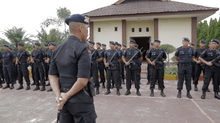 Pelopor
Pelopor Search and Rescue (SAR) unit
Search and Rescue (SAR) unit
Commanders

The highest command of Gegana operations is directly under the Indonesian National Police Chief (Kapolri). Heads of the Brimob Corps are as shown below:
- Commissioner of Police Mohammad Yasin
- Inspector General of Police S Y Wenas
- Inspector General of Police Firman Gani
- Inspector General of Police Imam Sudjarwo
- Inspector General of Police Syafei Aksal
- Inspector General of Police Unggung Cahyono
- Inspector General of Police M. Rum Murkal
- Inspector General of Police Robby Kaligis
- Inspector General of Police Murad Ismail (current)[9]
Gallery
|
See also
- Detachment 88 or Densus 88, Indonesian special counter-terrorism squad
References
- ↑ "Brigade Mobil Polisi Republik Indonesia", indonesiaeliteforces.tripod.com, retrieved 24 January 2017
- 1 2 International Business Publications USA, US-Indonesia Diplomatic and Political Relations Handbook, 2008
- ↑ Background on Kopassus and Brimob, etan.org, 2008, retrieved 6 March 2016
- 1 2 Kenneth Conboy, Simon McCouaig South-East Asian Special Forces, D3 Lieutenant, BRIMOB, 1983. Osprey, 1991
- ↑ Motto Brimob, Brimob Polri site, retrieved 6 May 2017
- ↑ Tugas Pokok, Fungsi dan Peranan Brimob, Bangka Belitung Regional Police Brimob Unit, retrieved 6 May 2017
- ↑ Brimob Pelopor Pasukan Elit Polri, Aulia Awaluddin, 30 July 2015, retrieved 6 May 2017
- ↑ Sat Brimob, Jambi Regional Police (Polda Jambi), 13 July 2015, retrieved 6 May 2017
- ↑ Murad Jadi Kakor Brimob, Siwalima, 4 January 2016, retrieved 6 May 2017
External links
- Video about Brimob
- 51 Tahun Si Baret Biru
- (in English) February 1962 – Summer 1963: In to Action
- Gegana Operators In Action on Instagram
